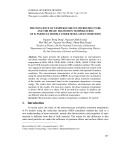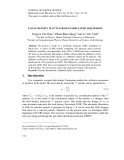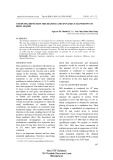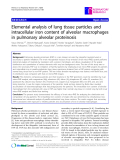
Iron particles
-
This paper presents the influence of temperature on microstructure and phase transition when heating 3000 nano-iron and bulk-iron particles at a temperature of 300 K, 500 K, 700 K, 900 K, 1100 K, 1300 K, 1500 K, 1700 K, 1900 K and 2100 K using the molecular dynamics (MD) simulation method.
 7p
7p  tamynhan8
tamynhan8
 04-11-2020
04-11-2020
 19
19
 2
2
 Download
Download
-
The diffusion coefficient is found to be a product of the rate of LDF and mean square displacement of Fe particles per LDF. The diffusion is realized by two types of activated LDFs. First type is accompanied by frequent back-and-forth movements of Fe particles. The second type causes the random movement of Fe particles.
 7p
7p  tamynhan8
tamynhan8
 04-11-2020
04-11-2020
 8
8
 1
1
 Download
Download
-
The goad of the thesis is to build the manufacture process of nano-sized magnetic fluids based on iron oxide (uniform particle size and high magnetic saturation) with stable technology; Characteristic research of magnetic properties of magnetic nanoparticles; assessment of toxicity and test of effects on cells, aiming to make contrast medicine in imaging diagnosis by magnetic resonance imaging (MRI), application on accurately identifying cancer.
 28p
28p  xacxuoc4321
xacxuoc4321
 08-07-2019
08-07-2019
 45
45
 5
5
 Download
Download
-
The main contents of the thesis: Synthesis and characterization of Fe3O4 nanoparticles, -Fe2O3 nanoparticles and γ-Fe2O3 nanoparticles by hydrothermal method. Compare the corrosion protection ability of epoxy film containing synthetic iron oxide particles. Fabrication and evaluation of steel corrosion protection effect of epoxy membrane containing magnetic iron oxide nanoparticles and nano iron oxide from organic denaturation with some silane compounds and with corrosion inhibiting compound.
 26p
26p  xacxuoc4321
xacxuoc4321
 08-07-2019
08-07-2019
 34
34
 6
6
 Download
Download
-
The dynamic properties of iron liquid (Fe) are studied by molecular dynamics (MD) simulation. We trace the evolution of local density fluctuations (LDFs) in Fe liquid over the simulation time and in the 300-2300 K temperature range. The result simulation reveals that atomic diffusion is realized through the LDFs and the high localization LDFs at low temperature in the iron liquid is the cause of the anomalous dynamics slowdown. We find that the diffusion depends on both rate of LDFs and the averaged square displacement of particles Fe as one LDF occurs.
 6p
6p  blackwidow123
blackwidow123
 15-06-2018
15-06-2018
 28
28
 3
3
 Download
Download
-
In this article, iron nanoparticles were synthesized by reduction of FeCl3.6H2O 0,045M using NaBH4 0,25M. Characteristics of obtained iron particales were studied by Transmission Electron Microscopy (TEM), X-ray diffraction method (XRD) and BET specific surface area, and maximum benzen adsorption. The TEM results of synthesized iron nanoparticales show that iron particles are spherical in shape and connected in chains, the particale size is about 3 - 50nm. The X-ray results show that synthesized nanoparticles is iron at 44.720.
 4p
4p  uocvong02
uocvong02
 24-09-2015
24-09-2015
 59
59
 3
3
 Download
Download
-
In this article, iron nanoparticles were synthesized by reduction of FeCl3.6H2O 0,045M using NaBH4 0,25M. Characteristics of obtained iron particales were studied by Transmission Electron Microscopy (TEM), X-ray diffraction method (XRD) and BET specific surface area, and maximum benzen adsorption. The TEM results of synthesized iron nanoparticales show that iron particles are spherical in shape and connected in chains, the particale size is about 3 - 50nm. The X-ray results show that synthesized nanoparticles is iron at 44.720.
 4p
4p  tuanloc_muido
tuanloc_muido
 11-12-2012
11-12-2012
 51
51
 7
7
 Download
Download
-
Tuyển tập các báo cáo nghiên cứu về y học được đăng trên tạp chí y học 'Respiratory Research cung cấp cho các bạn kiến thức về ngành y đề tài: " Elemental analysis of lung tissue particles and intracellular iron content of alveolar macrophages in pulmonary alveolar proteinosis...
 7p
7p  toshiba11
toshiba11
 20-10-2011
20-10-2011
 65
65
 3
3
 Download
Download
-
The atomic theory of matter specifies that each of the many chemical elements is composed of unique and identifiable particles called atoms. In ancient times only 10 were known in their pure, uncombined form; these were carbon, sulfur, copper, antimony, iron, tin, gold, silver, mercury, and lead.
 30p
30p  thachsaudoi
thachsaudoi
 23-12-2009
23-12-2009
 67
67
 8
8
 Download
Download
CHỦ ĐỀ BẠN MUỐN TÌM





















